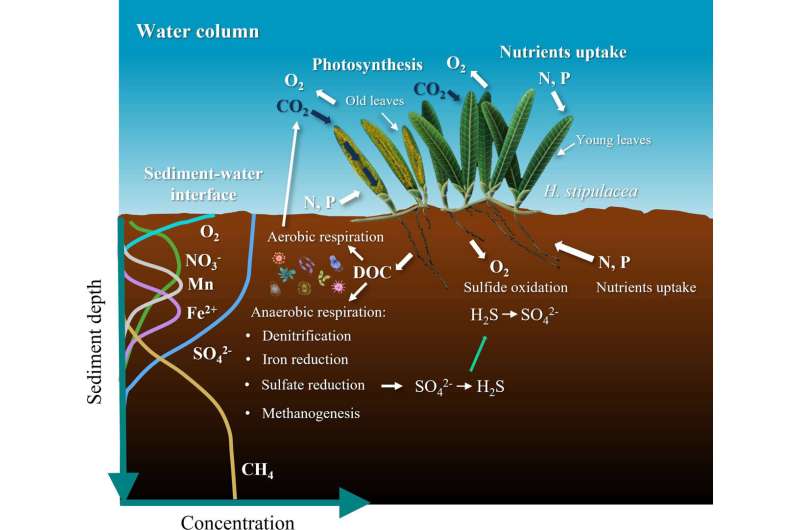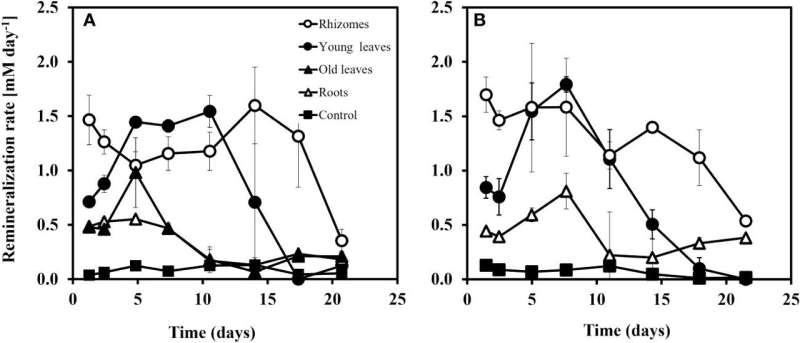November 8, 2023 feature
This article has been reviewed according to Science X's editorial process and policies. Editors have highlighted the following attributes while ensuring the content's credibility:
fact-checked
peer-reviewed publication
trusted source
proofread
Seagrass decline poses issues for carbon storage projects

Climate change is an ever-pressing concern, with innovative ways to remove excess carbon from the atmosphere a continued focus of scientists. One such carbon sequestration method turns to an unlikely sink—seagrass—a marine flowering plant (angiosperm) that is found in shallow coastal waters up to 50m depth on all continents except Antarctica.
Studies suggest that though they may only cover a mere 0.2% of the ocean floor, they have the capability of storing a substantial 15% of oceanic carbon. The rhizosphere (a subsurface zone surrounding roots and rhizomes, underground stems from which a new plant can sprout) around these angiosperms is a prime microenvironment for redox (reduction and oxidation) reactions that enrich the surrounding sediment in organic matter and permit carbon remineralization of plant components.
However, worldwide seagrass populations have been declining 7% annually since 1990 due to local threats, such as coastal erosion, human development and eutrophication (excessive algal growth due to high nutrient concentrations), as well as from global warming, posing a real threat to the drawdown of carbon from the oceans and atmosphere.
New research, published in Frontiers in Marine Science, reveals experimental results from samples collected from the Gulf of Aqaba in the Red Sea in 2022, which contained different elements of the small (leaf length ~4–6 cm) tropical seagrass Halophila stipulacea, a hardy plant that thrives in a variety of sediments. This included roots, rhizomes, young and old leaves that were ground into small particles and suspended in a sediment slurry for 25 days.
Neta Soto, of Ben-Gurion University of the Negev, Israel, and colleagues measured the changes in certain elements and compounds (ferrous iron, hydrogen sulfide, sulfate and dissolved inorganic carbon) in the porewater of the slurry through time to determine remineralization rates of the various seagrass components.

The research team found that the fastest decomposition and increase in dissolved organic carbon occurred in rhizomes (due to high concentrations of sugars and starch), followed by young leaves, then roots and finally old leaves. Rhizome remineralization was a sustained high for 15 days before this process began to rapidly reduce, while young leaf remineralization surpassed that of rhizomes but only after a five-day delay. Root remineralization was observed to decline after just 48 hours from one of the sample sites.
With high anaerobic remineralization rates, Soto and colleagues determined a consequent 50% loss of organic carbon storage in the surrounding sediment from rhizomes, 30% from young leaves, and 15% each from old leaves and roots. This means that the below-ground biomass of roots is an important sink of organic carbon due to slower decomposition rates, while above-ground elements release dissolved organic carbon back into the water column more quickly.
High concentrations of hydrogen sulfide predominated in slurries containing rhizomes and young leaves, with augmented rates of mortality caused by accumulation of this compound, which is toxic to oxygen-respiring organisms. Decomposition produces more sulfide to generate a positive feedback loop that negatively impacts surrounding seagrass plants. With the decline of seagrass, this prevents the plants transporting oxygen to their roots and pushing this out into the rhizosphere, with anoxic conditions inhibiting the respiration of burrowing organisms and the various processes of the carbon cycle.
Indeed, at the study sites, the scientists found that oxygen penetrates just 3 mm into the sediment in the shallower part of the basin up to 20 m water depth. The lack of burrowing activity can also lead to the production of methane, which is a damaging greenhouse gas that has 28–34 times the warming potential of carbon dioxide over 100 years.
In addition to biological processes impacting Blue Carbon storage (the carbon captured by the world's oceans and coastal ecosystems), the grain size of sediment plays an important role in opening pore space, while location provides wind-blown minerals in dust that transport elements vital for the carbon cycle. Not only is the decline in seagrass therefore an issue for drawing down carbon, but it also negatively impacts ocean acidification, exacerbating the devastation seen to coral reefs in recent years.
More information: Neta Soto et al, The effect of anaerobic remineralization of the seagrass Halophila stipulacea on porewater biogeochemistry in the Gulf of Aqaba, Frontiers in Marine Science (2023). DOI: 10.3389/fmars.2023.1250931
Journal information: Frontiers in Marine Science
© 2023 Science X Network




















